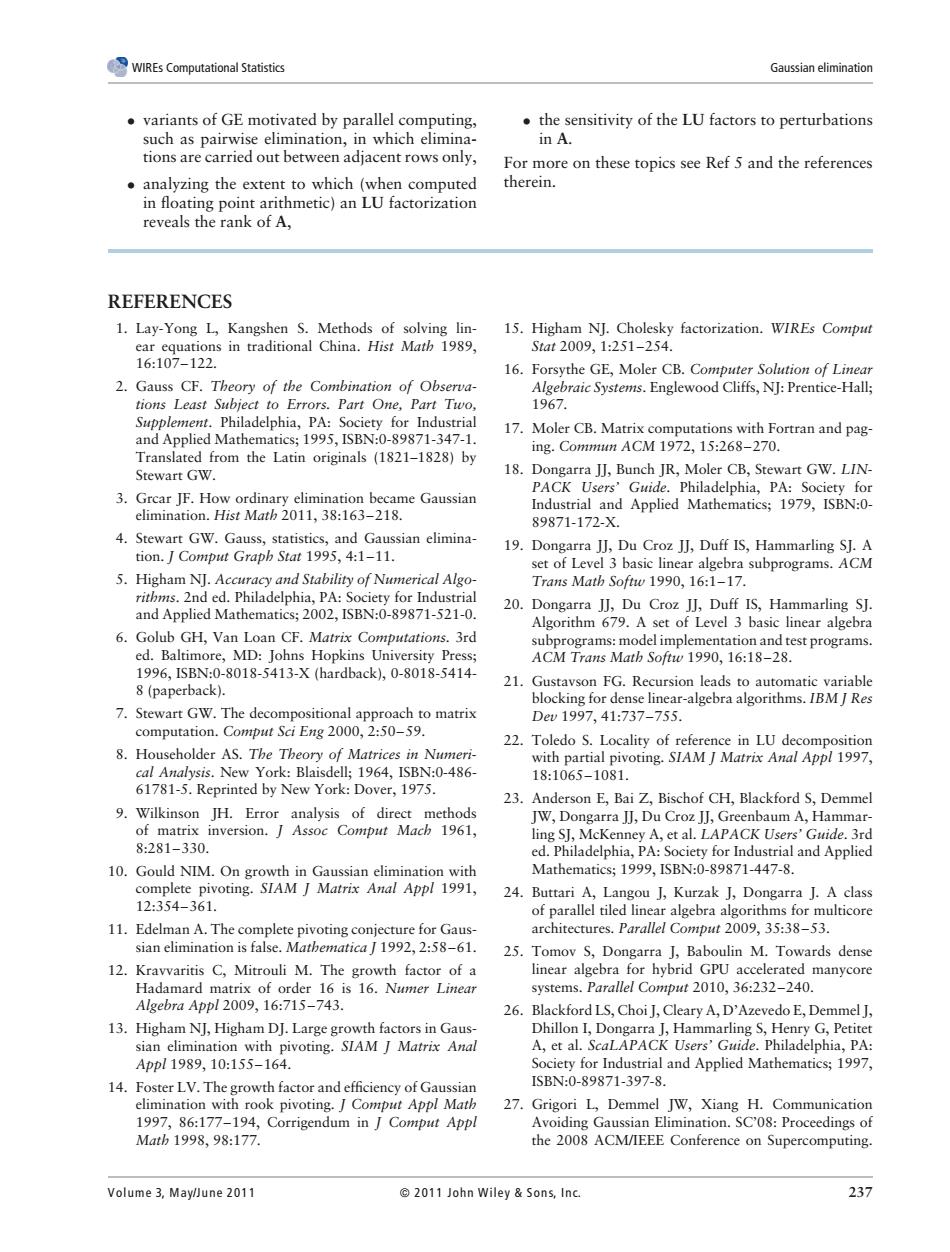正在加载图片...

WIREs Computational Statistic variant ts of GE mo tions are carried out between adiacent rows only. which (when co reveals the rank of A, REFERENCES 2C. CE Th f the comhination of ohe 1967 NJ:Prentice-Hall 17 Moler CB Matriy img.1972,15-268-270. ith Fortran and pag Translated from the Latin originals (1821-1828)by Stewart GW. 18.D H GW.LIN Philadelphia, PA 9.Do I.Du Croz I.Duff Is Ham Trans Math Softw 1990,16:1-17. PA and Applied Mathematics:2002.ISBN:0-89871-521-0 69. 6.Golub GH,Van Loan CF.Matrix Computations.3rd 19.IBN0-01b 0-0- 8(paperback). 21.Gustayson FG.Recursion leads to automatic variable 7.Stewart GW.The deco ach to matrix 22. 8.Householder AS.The Theory of Matrices in Numeri Toledo S. York:964 190486 18:1065-1081. 23.Anderson E.Bai Z.Bischof CH.Blackford S.Demme 9 ongarra J,Du Croz Gre mmar 8:281-330. hia.PA for Ind Mathematics:1999,ISBN:0-89871-447-8. 24.Buttari A,Langou J,Kurzak J,Dongarra J.A class 11. Edel 12.Kray ritis C Mitrouli M.The of Donga rd GPU lin M M.Towards dens systems.Parallel Comput 2010,36:232-240. 26.Blackford LS.Choi I.Cleary A.D'Azevedo E.Demmel I ty for industrial and applied mathematics:1997 LV.T 1BN:0-89871-397-8. omput appl math Corrigendum in Comput App Math1998,98:177. Volume 3.Mayuune 2011 2011 John wiley sons.Inc 237WIREs Computational Statistics Gaussian elimination • variants of GE motivated by parallel computing, such as pairwise elimination, in which eliminations are carried out between adjacent rows only, • analyzing the extent to which (when computed in floating point arithmetic) an LU factorization reveals the rank of A, • the sensitivity of the LU factors to perturbations in A. For more on these topics see Ref 5 and the references therein. REFERENCES 1. Lay-Yong L, Kangshen S. Methods of solving linear equations in traditional China. Hist Math 1989, 16:107–122. 2. Gauss CF. Theory of the Combination of Observations Least Subject to Errors. Part One, Part Two, Supplement. Philadelphia, PA: Society for Industrial and Applied Mathematics; 1995, ISBN:0-89871-347-1. Translated from the Latin originals (1821–1828) by Stewart GW. 3. Grcar JF. How ordinary elimination became Gaussian elimination. Hist Math 2011, 38:163–218. 4. Stewart GW. Gauss, statistics, and Gaussian elimination. J Comput Graph Stat 1995, 4:1–11. 5. Higham NJ. Accuracy and Stability of Numerical Algorithms. 2nd ed. Philadelphia, PA: Society for Industrial and Applied Mathematics; 2002, ISBN:0-89871-521-0. 6. Golub GH, Van Loan CF. Matrix Computations. 3rd ed. Baltimore, MD: Johns Hopkins University Press; 1996, ISBN:0-8018-5413-X (hardback), 0-8018-5414- 8 (paperback). 7. Stewart GW. The decompositional approach to matrix computation. Comput Sci Eng 2000, 2:50–59. 8. Householder AS. The Theory of Matrices in Numerical Analysis. New York: Blaisdell; 1964, ISBN:0-486- 61781-5. Reprinted by New York: Dover, 1975. 9. Wilkinson JH. Error analysis of direct methods of matrix inversion. J Assoc Comput Mach 1961, 8:281–330. 10. Gould NIM. On growth in Gaussian elimination with complete pivoting. SIAM J Matrix Anal Appl 1991, 12:354–361. 11. Edelman A. The complete pivoting conjecture for Gaussian elimination is false. Mathematica J 1992, 2:58–61. 12. Kravvaritis C, Mitrouli M. The growth factor of a Hadamard matrix of order 16 is 16. Numer Linear Algebra Appl 2009, 16:715–743. 13. Higham NJ, Higham DJ. Large growth factors in Gaussian elimination with pivoting. SIAM J Matrix Anal Appl 1989, 10:155–164. 14. Foster LV. The growth factor and efficiency of Gaussian elimination with rook pivoting. J Comput Appl Math 1997, 86:177–194, Corrigendum in J Comput Appl Math 1998, 98:177. 15. Higham NJ. Cholesky factorization. WIREs Comput Stat 2009, 1:251–254. 16. Forsythe GE, Moler CB. Computer Solution of Linear Algebraic Systems. Englewood Cliffs, NJ: Prentice-Hall; 1967. 17. Moler CB. Matrix computations with Fortran and paging. Commun ACM 1972, 15:268–270. 18. Dongarra JJ, Bunch JR, Moler CB, Stewart GW. LINPACK Users’ Guide. Philadelphia, PA: Society for Industrial and Applied Mathematics; 1979, ISBN:0- 89871-172-X. 19. Dongarra JJ, Du Croz JJ, Duff IS, Hammarling SJ. A set of Level 3 basic linear algebra subprograms. ACM Trans Math Softw 1990, 16:1–17. 20. Dongarra JJ, Du Croz JJ, Duff IS, Hammarling SJ. Algorithm 679. A set of Level 3 basic linear algebra subprograms: model implementation and test programs. ACM Trans Math Softw 1990, 16:18–28. 21. Gustavson FG. Recursion leads to automatic variable blocking for dense linear-algebra algorithms. IBM J Res Dev 1997, 41:737–755. 22. Toledo S. Locality of reference in LU decomposition with partial pivoting. SIAM J Matrix Anal Appl 1997, 18:1065–1081. 23. Anderson E, Bai Z, Bischof CH, Blackford S, Demmel JW, Dongarra JJ, Du Croz JJ, Greenbaum A, Hammarling SJ, McKenney A, et al. LAPACK Users’ Guide. 3rd ed. Philadelphia, PA: Society for Industrial and Applied Mathematics; 1999, ISBN:0-89871-447-8. 24. Buttari A, Langou J, Kurzak J, Dongarra J. A class of parallel tiled linear algebra algorithms for multicore architectures. Parallel Comput 2009, 35:38–53. 25. Tomov S, Dongarra J, Baboulin M. Towards dense linear algebra for hybrid GPU accelerated manycore systems. Parallel Comput 2010, 36:232–240. 26. Blackford LS, Choi J, Cleary A, D’Azevedo E, Demmel J, Dhillon I, Dongarra J, Hammarling S, Henry G, Petitet A, et al. ScaLAPACK Users’ Guide. Philadelphia, PA: Society for Industrial and Applied Mathematics; 1997, ISBN:0-89871-397-8. 27. Grigori L, Demmel JW, Xiang H. Communication Avoiding Gaussian Elimination. SC’08: Proceedings of the 2008 ACM/IEEE Conference on Supercomputing. Volume 3, May/June 2011 2011 John Wiley & Son s, In c. 237